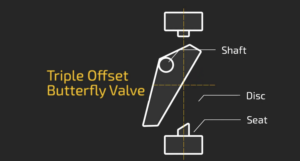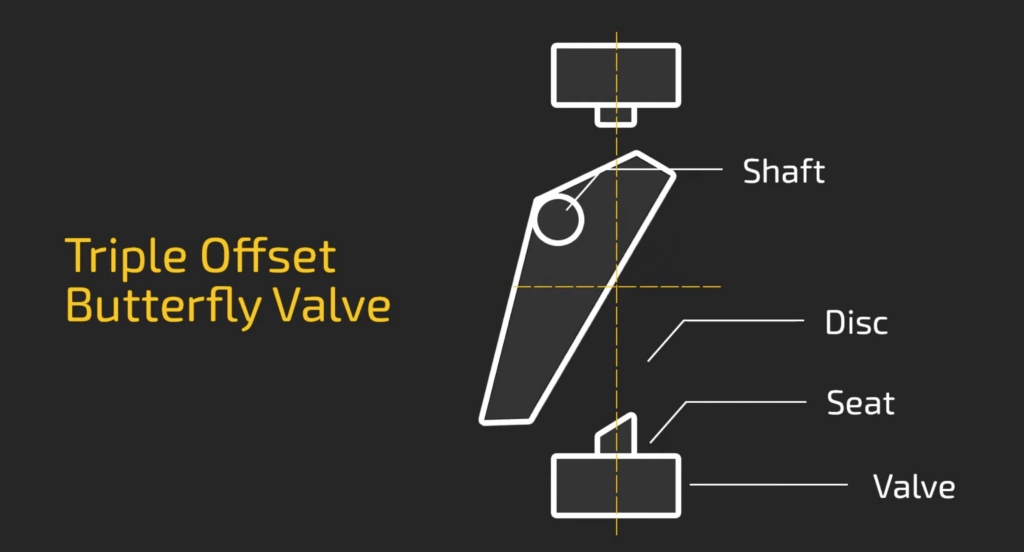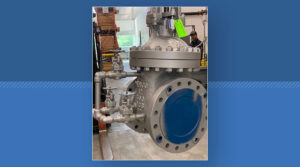
Triple Offset Butterfly Valve – Benefits, Drawing, vs Other Offsets
Choosing the right type of butterfly valve is key to every application. The available range of butterfly valves from equipment manufacturers includes concentric, single (1x) offset, double (2x) offset, and triple (3x) offset butterfly valves. In this article, you will learn the benefits of a triple offset butterfly valve, see a sample drawing, and realize its benefits vs other types of butterfly valves.
Benefits of a Triple Offset Butterfly Valve
Triple offset, as the name implies, uses three separate offsets to achieve a bubble-tight shut-off. One of the offsets applies to the location of the valve shaft relative to the centerline of the bore. Another offset is between the centerline of the disc/seat sealing surface and the shaft. Then, the third offset is the geometry of the seating surface, which creates a cone shape of the disc and seat. The combination of these three offsets gives this valve its key benefits which are as follows:
- Geometric Design: The design of the sealing components takes up a right-angle cone shape. Resulting in a cam-action and right-angled design where the sealing components are never in contact until their final degree of closing. Thus, enabling a repeatable sealing and an extended valve life because of its friction-free nature. In addition, the friction-free stroking throughout the valve allows for a relatively lower torque actuator to be used in operating this type of valve. Such a design makes it ideal for automation.
- Metal-to-Metal Seal: Because of the frictionless sealing mechanism, triple offset butterfly valves use a metal-to-metal seal. This enables a tight shutoff in high-pressure and high-temperature systems. Applications that use friction in sealing often use elastomers or soft material for the valve trim, which may deteriorate with increasing temperature or when the valve is subjected to corrosion. But with the triple offset, corrosion-resistant alloys can serve for both the valve disc and seat, to deliver zero leakage performance.
- Absence of Cavities: In a triple-offset valve, there are no cavities between sealing components. Therefore, there is no room for debris to clog and disrupt the sealing mechanism, unlike gate and ball valves. This minimizes maintenance costs and extends the valve life.
Triple Offset Butterfly Valve Sample Drawing

A sample drawing of a triple offset butterfly valve above clearly highlights its three offsets. The first offset (offset 1) is between the axle center of the valve stem and the valve body centerline or sealing surface. This design helps to minimize the squeezing complications between the disc and seat that are found in concentric butterfly valves. However, friction between the seat and disc remains a challenge. For this reason, the double offset design sees seldom use.
The second offset (offset 2) is between the axle center of the valve stem and the centerline of the bore/pipe. This leads to minimal friction as the valve opens and closes. In combination with the first offset, the valve’s operational life extends.
The third offset is that of the cone axis that deviates from the axle centerline and thus eliminates friction completely. Users can expect longer seat life in the triple offset butterfly valve because the sealing mechanism relies on contact pressure rather than elastic deformation of the valve seat.
Benefits vs Other Valve Types
This section compares the features of the triple offset butterfly valve to other types of butterfly valves.
Single Offset vs Triple Offset
The single offset butterfly valve is not common in the market because it shares a lot of similarities with the concentric/zero offset valve. Below is a table highlighting the differences between the single and triple offset valves.
| Feature | Single Offset/Concentric Valve | Triple Offset Valve |
| Seal type | The valve seat is usually made from polymers or other soft materials to enable a friction seal with the metal disc. | The three offsets allow for metal-to-metal seals using alloys for both the seat and disc. |
| Seat friction | High, because friction is the basic sealing mechanism. Thus, it is susceptible to wear and results in a shorter seat lifespan. | Seat friction is insignificant because sealing is by contact pressure. As a result, the valve seat enjoys much longer operational life. |
| ANSI pressure class rating | Although this valve can deliver bubble-tight shut-off, its inferior sealing mechanism, and susceptibility to wear limit this to class 150. | Delivers dependable sealing which does not wear easily. Models such as the Durco triple offset can achieve a 1500-pound rating. |
| Fluid services | Because of its friction sealing mechanism, it is only effective with clean fluid. | The triple offset sealing mechanism is more tolerable to dirt, so works with clean or dirty fluids. |
| Applications | Common in utilities and domestic applications. | Can function effectively in severe service and high cyclic operations. |
Double Offset vs Triple Offset
The double offset valve is an improvement of the concentric/single offset valve and provides more versatility than the single offset. Feature comparisons are noted between the double and triple below:
| Feature | Double Offset Valve | Triple Offset Valve |
| Seal type and friction | When compared to the single offset, the double offset greatly reduces friction. However, it still relies on plastic deformation for sealing. As a result, soft materials are still used for the valve seat. | Maintains metal-to-metal seal with contact pressure. |
| Fluid service | Suitable for handling clean fluids only, due to friction in its sealing mechanism. | Maintains effectiveness, even in dirty fluids. |
| Applications | Can serve in several industrial applications including water treatment, chemicals, oil and gas, and HVAC. | Also serves in industrial applications, but suits scenarios with higher operational demand. |
| Cost | Comes at a moderate cost i.e. more expensive than single offset valves but less than triple offset valves. | The specialized machining required to achieve superior sealing makes it more expensive. |


